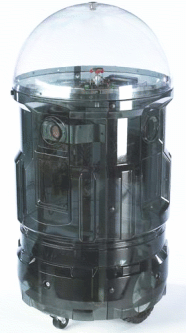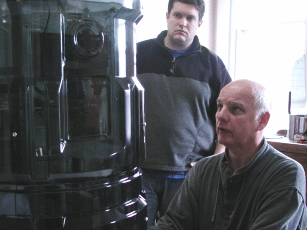First robot-to-robot email exchange?
Jun 12, 2003 — by LinuxDevices Staff — from the LinuxDevices Archive — 4 viewsTuesday June 10, 2003 may well go down in history as the date when autonomous mobile robots first began exchanging email with each other over the Internet.
Allow me to explain . . .
The test
It all began when software engineer Dennis Koch, sitting with a wireless laptop in a restaurant located in part of the building occupied by Smart Robots, maker of the Smart Robots SR4 Autonomous Mobile Robot, fired off an email to Smart4, one of two wireless SR4 robots in the test. Koch's email requested the temperatures at both the office and the home of Joe Bosworth, his company's CEO, who lives about a mile away.
 Moments later, Smart4, located in Bosworth's office, received the message and shot back a reply to Koch with five rapid-fire readings from its temperature sensor. Smart4 then sent a similar message to a second SR4 robot, Watson, located in Bosworth's home. (Incidentally, in case you haven't already grasped the momumental nature of this occasion, Watson is named after Thomas A. Watson, the assistant to Alexander Graham Bell who received Bell's first successful experimental phone message back in 1876.)
Moments later, Smart4, located in Bosworth's office, received the message and shot back a reply to Koch with five rapid-fire readings from its temperature sensor. Smart4 then sent a similar message to a second SR4 robot, Watson, located in Bosworth's home. (Incidentally, in case you haven't already grasped the momumental nature of this occasion, Watson is named after Thomas A. Watson, the assistant to Alexander Graham Bell who received Bell's first successful experimental phone message back in 1876.)
Watson, receiving the message from Smart4, sent back a set of five temperature readings to Koch, who was still sitting with his laptop in the restaurant. The whole exchange took but a few moments, from when Koch sent the initial message to Smart4.
And history was made.
People emailing robots. Robots emailing robots. Robots emailing people.
Little may surprise us about what is possible over the Internet or the World Wide Web as it is otherwise known. The robots in this experiment (models SR4-P and above) come equipped with the ability to wirelessly hook into the Internet using the standard Wi-Fi wireless networks increasily found in many homes and offices.
But were the parties in this experiment really talking to one another and understanding one another? Well, the answer is a qualified yes. Through the use of XML, or eXtensible Markup Language, people can speak to machines (robots, in this case), by sending messages with code tags around the meaningful parts of the message — for example  action> being a possible tag signifying that the following text is an action request of the recipient by the sender. In this case, the full line of text might be
action> being a possible tag signifying that the following text is an action request of the recipient by the sender. In this case, the full line of text might be  action>temperature
action>temperature /action>, with a tag at both ends indicating the beginning and the end of the action request, and the action request text itself being the word “temperature”.
/action>, with a tag at both ends indicating the beginning and the end of the action request, and the action request text itself being the word “temperature”.
The robot at the receiving end of this message has the ability to recognize code words (tags) and isolate the meat of the message, in this case the text between the tags: “temperature”. The robot's programming enables it to interpret this message (or other similar messages) and take an appropriate action associated in the robot's memory with that message. The robot acquires the temperature readings from its on-board temperature sensor, and quickly sends the temperature readings to an email address received in the initial message, bracketed by email address tags. (Note: the actual XML code used in Tuesday's demonstration is somewhat different than this, but works in quite the same way.)
The future
In Tuesday's experiment, the first robot shot off a message requesting the temperature from the second robot, which happened to be sitting a mile away in Bosworth's home — but it could just as easily have been half-way around the world. The second robot received and interpreted the message and then took its own temperature readings and returned them to Koch.
The “qualified yes” above, in answer to the question of the robot's understanding, is meant to underscore that it will be quite a while — if it is to happen at all — before a machine can really be said to “understand” in a conscious sense what is going on around it. But smarter and smarter machines should eventually be able to respond to many events and circumstances with appropriate responses that make them seem intelligent, if not understanding as well.
Today's SR4 robot offers students, engineers, hobbyists, and educators an educational and experimental platform for learning and applying Linux, Java, XML, Web Services, Wireless Ethernet Networking and other information technology skills that are in demand in the computer field. Younger students in elementary grades can practice their language and math skills by “teaching” the robot these same skills. Others will find the robot useful in learning about electronics, robotics, and sensor technology.
And all of this while having some fun with a new technology!
Further info . . .
- The SR4 Robot's Java CVM comes from Apogee Software Inc..
- The robot's XML parser is open source software, available from Kxml.org.
- The SR4 operates on GNU Linux Kernel version 2.4.19 distributed by Technical Solutions.
- For full details on the SR4 Robot, visit the website of Smart Robots, the robot's manufacturer.
 About the author: Joe Bosworth (seated) designed and introduced the RB5X Intelligent Robot which preceded Heath's Hero to market by a month or so, and so was the first of its kind in “mass” production to hit the market. He also founded, with Nelson Winkless, the National Personal Robot Association (NPRA) and went on to chair the first IPRC in Albuquerque — 500 seminar attendees, 3000 exhibit attendees. “What a great time it was, on the heels of George Lucas' first Star Wars episode,” says Bosworth.
About the author: Joe Bosworth (seated) designed and introduced the RB5X Intelligent Robot which preceded Heath's Hero to market by a month or so, and so was the first of its kind in “mass” production to hit the market. He also founded, with Nelson Winkless, the National Personal Robot Association (NPRA) and went on to chair the first IPRC in Albuquerque — 500 seminar attendees, 3000 exhibit attendees. “What a great time it was, on the heels of George Lucas' first Star Wars episode,” says Bosworth.
This article was originally published on LinuxDevices.com and has been donated to the open source community by QuinStreet Inc. Please visit LinuxToday.com for up-to-date news and articles about Linux and open source.